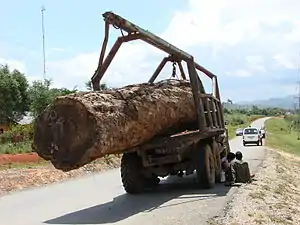Bolaven Plateau
The Bolaven Plateau is an elevated region in southern Laos. Most of the plateau is located within Champasak Province of Laos, though the edges of the plateau are also located in Salavan, Sekong and Attapeu Provinces. It is located between the Annamite Mountain Range, along which runs Laos' eastern border with Vietnam, and the Mekong River to the west, at about 15°N 106°E. The plateau's elevation ranges approximately from 1,000 to 1,350 metres (3,280 to 4,430 ft) above sea level. The plateau is crossed by several rivers and has many scenic waterfalls. The name Bolaven makes reference to the Laven ethnic group which has historically dominated the region. However, domestic migrations by the Lao ethnic group (which comprises approximately 50 to 60 percent of the population of Laos) has resulted in widespread interethnic marriage, thus modifying the ethnic composition of the region.




Historical significance
The Bolaven Plateau has had an important role in the greater history of Laos. The three most significant historical periods which have greatly affected the area are the French colonization of the region, the Phu Mi Bun Revolt, and the Vietnam War. Each event has had a significant effect upon the Plateau and given the area its own unique character and importance.
French colonization
In 1893, the French first annexed territories east of the Mekong River and later annexed minor extensions of land to the west of the Mekong in 1904 and 1907.[1] For the Bolaven Plateau, the period of French colonization in Laos is most significant because of the agricultural techniques acquired from the French by the inhabitants. According to the Historical Dictionary, "the French planted coffee and experimented with rubber, and the plateau has remained an important agricultural area growing a wide variety of fruit and vegetables, as well as cash crops".[2] It was not until the French introduced farming to the region in the early 20th century that the residents of the Bolaven Plateau made the area an agricultural sector.
The second period that helps define the history of the Plateau is the Phu Mi Bun Revolt. The revolt erupted in 1901 and was not suppressed until 1907. It was a “major rebellion by local Lao Theung tribes (the Alak, Nyaheun and Laven) against French domination".[2] Though there is not extensive literature on these particular revolutionary revolts in the Bolaven Plateau, one can see that the native communities desired to rid the region of the extensive and overpowering influence of their colonizers.[3]
The Vietnam War
The Bolaven Plateau greatly suffered during the Vietnam War. The Bolaven Plateau was one of “the most heavily-bombed theatres of the Second Indochina War, US bombardment became unbearable in the late ’60s. Controlling the Bolaven Plateau was considered strategically vital to both the Americans and North Vietnamese, as evidenced by the staggering amount of UXO (unexploded ordnance) still lying around”.[4] Since there is a great deal of UXO lying around the Plateau, it is often dangerous to veer off unmarked paths. According to many accounts, the devastation caused by these bombings can still be seen in some areas, though most edifices have been rebuilt. In addition, the mere fact that the Plateau is one of the areas passed through on the Ho Chi Minh Trail (The trail does not pass through the plateau but, rather, just off the east edge of the plateau. During the war the plateau was accessible by vehicle via Paksong and Thateng and those roads were the only roads that led off the plateau.) still attracts tourists and brings further attention to the region.[5] Thus, the three aforementioned events are unique historical incidents which have directly affected the Bolaven Plateau.
Culture
The predominant ethnic group in the Bolaven Plateau is the Laven, though other Mon-Khmer ethnic groups reside in the area including the Alak, Katu, Taoy, and Suay.[4] According to CPA Media, "all of these people follow animist belief systems" with some groups practicing animal sacrifices. However, more recently, some of these minority communities have begun to adopt Buddhist beliefs because of their contact with Lao Loum.[6]
Economy
Literature on the Bolaven Plateau often focuses on two primary economic contributors to the region: agricultural production and tourism. Both contribute greatly to the Plateau’s revenue.
The French first began farming and other agricultural techniques in the Bolaven Plateau including the production of coffee, rubber, and bananas in the early 20th century. Since the French's initial influence, "the plateau remained an important agricultural area growing a wide variety of fruit and vegetables, as well as cash crops such as cardamom".[6] However, it was the French introduction of the production of coffee that has proved most useful to the region.
During colonization, the French introduced the production of “high quality stock of both Arabica and Robusta strains. Production declined during the war years, but is now experiencing a renaissance”.[7] The climate of the Plateau with its cooler temperatures and abundant rainfall makes it the perfect place for coffee production. Most farming families that make up a variety of the aforementioned minority groups are highly dependent on the coffee industry as their source of income. Coffee in Laos is "cultivated almost exclusively on the Bolaven Plateau in Champasak Province in the southern part of the country... Currently, the Lao coffee harvest generates about 15–20,000 tons a year, 80% of which is Robusta."
Tourism
Tourism has taken a hold in the Bolaven Plateau because of the unique aspects of the region that have triggered great intrigue. The most popular places visited by tourists are the waterfalls in the region, the villages of the ethnic minorities, and other geopolitical areas of interest.
The Bolaven Province has a number of waterfalls. The Tad Lo Waterfalls that are approximately 58 miles from northeast Pakse are a common destination. The "lush vegetation" that surrounds the waterfall makes it a desired destination though the fall itself "drops only a few meters".[7] In addition, one can go "beyond Paksong on the way to Pakse [where] another spectacular waterfall, Taat Fang (also known as Dong Hua Sao), tumbles 120 metres, making it the tallest waterfall in Laos. Well-marked trails lead the physically fit 6 kilometres to the base of the falls":.[7]
Tourist attractions also include the villages of ethnic minorities who have grown accustomed to sharing their culture with visitors to the region. Travel guides inform visitors of nearby villages that can be visited: "Alak, Katu and Suay villages can be found within a few kilometres of the resort".[7] Tourists are also informed of the markets where they can go and observe the cultures of ethnic minorities and purchase items unique to each culture.
The Bolaven Plateau is filled with cultural and geographical areas of interest. Whether it is a boat trip to one of the waterfalls that occupy the region, a tour of the area's coffee plantations, an elephant day trek, or visiting one of the villages of the ethnic minorities, a journey to the Plateau has many opportunities for tourists.[8]
Impact crater
Researchers believe that a meteorite, about 2 kilometres (1.2 mi) wide, struck Earth approximately 790,000 years ago, with its impact crater perhaps buried under Bolaven Plateau volcanic field, as its strewn tektites were found across Asia, Australia, and Antarctica.[9]
References
- Fox-Stuart, Martin (Winter 1995). "The French in Laos, 1887–1945". Modern Asian Studies. 29:1 p. 111. doi:10.1017/S0026749X00012646.
- Stuart-Fox, Martin (2001). Historical Dictionary of Laos. Second Edition. Asian/Oceanian Historical Dictionaries Series No. 35. Maryland: The Scarecrow Press.
- Murdoch, John B. (1974). "The 1901–1902 Holy Man's Rebellion" (free). Journal of the Siam Society. Siam Heritage Trust. 62 (1). Retrieved April 2, 2013.
The 'Holy Man's' uprising of 1901–1902 was a large scale popular rebellion involving Northeast Thailand, Southern Laos, and the adjacent portion of the Vietnamese Central Highlands. Scholarship to date has not adequately considered the rebellion's character as transcending present national boundaries, having common leadership, and growing out of common regional causes.
- Lonely Planet. 2009. “Introducing Bolaven Plateau.” URL: http://www.lonelyplanet.com/laos/southern-laos/bolaven-plateau
- Legend of the, Ho Chi Minh trail | Laos GPS Map
- Fox-Stuart, Martin (2008). Historical Dictionary of Laos. Third Edition. Asian/Oceanian Historical Dictionaries Series No. 68. USA: The Scarecrow Press.
- CPA Media: The Asia Experts. 2009. "From Champasak to the Bolaven Plateau." URL: "Archived copy". Archived from the original on 2008-09-24. Retrieved 2009-02-16.CS1 maint: archived copy as title (link)
- http://www.southern-Laos.com/spip.php?article7&lang=enSouthern-Laos.com/Bolaven-Plateau Archived 2016-03-05 at the Wayback Machine
- Kerry Sieh; Jason Herrin; Brian Jicha; Dayana Schonwalder Angel; James D. P. Moore; Paramesh Banerjee; Weerachat Wiwegwin; Vanpheng Sihavong; Brad Singer; Tawachai Chualaowanich; Punya Charusiri (2020). "Australasian impact crater buried under the Bolaven volcanic field, Southern Laos". Proceedings of the National Academy of Sciences. Proceedings of the National Academy of Sciences of the United States of America. 117 (3): 1346–1353. Bibcode:2020PNAS..117.1346S. doi:10.1073/pnas.1904368116. PMC 6983392. PMID 31889003.
External links
 Media related to Bolaven Plateau at Wikimedia Commons
Media related to Bolaven Plateau at Wikimedia Commons